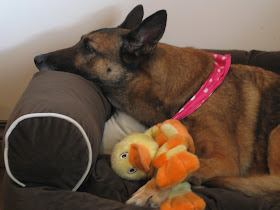 My Belgian Malinois, Bella aka Rou Rou, is keeping me company as I write this post.
My Belgian Malinois, Bella aka Rou Rou, is keeping me company as I write this post.Sunday
1. What is a good humidity level in the aviary - especially when hens are setting on eggs?
I like to start breeding when the Goldfinches outside turn yellow and Spring Rains have started which is usually late March. Spring rains keep the humidity in a good range which is considered to be 55% to 70%. The lower % is more desired as at higher levels there is a higher risk of proliferation of pathogenic (disease causing) organisms. Too low humidity is a cause of hatching problems and possibly infertility.
Wichita had snow last week and some is still on the ground. The weatherman reported last night that current humidity is running 45% with moisture expected a couple of days this week. By waiting for the Spring rains before breeding, I am ensured that my aviary humidity level will be in a good range for hatching.
Sometimes humidity levels are blamed for poor hatching when the problem is actually that the egg shell is so thin that the eggs are drying out so much that either the yolk is dehydrated and solid so that even fertile eggs will not have a chick develop or the chick has trouble piping through the dry tough membrane to the air space and without breaking through to the air space, the chick will die in the shell.
Calcium, magnesium, and vitamin D3 in the right proportions are need for good quality egg shells. Some breeds such as Staffords have an easy time absorbing these necessary nutrients where other varieties such as Borders are especially high risk for porous poor quality egg shells that dry out and make either fertile egg development or piping through to start hatching impossible.
Any egg that does not hatch should be opened and examined to see why it did not produce a viable chick.
I just checked and it is 82% humidity in Portland, Oregon right now. I don't think we dry out to your standards until late September :)
ReplyDeleteLast evening the humidity here was 72%.
ReplyDeletewith heat on in the house, we run the humidifier at 35% as our skin gets to itching if the humidifier is not on in the winter time.
What we need is readings on the humidity in the aviary?
For me, the only trouble I have with dead in the shell is if the shells are not strong but rather porous.
Do you see problems Richard with dead in the shell?
What mineral supplements do you use?
Wisconsin Humidity 86% and very snowy.
ReplyDeleteWe have to monitor the in house humidity. We keep a humidifier in the lower level family room(near the aviary) 30 to 35% makes it cozy for everyone.
The parrots and canaries love to be misted to keep their feather preened.
I used to lose a couple of nests per year to dead in shell babies.
Since I have been monitoring the humidity no losses.